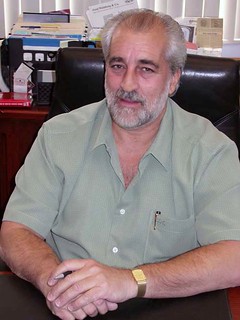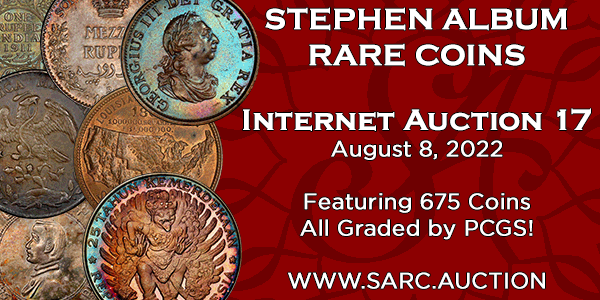
PREV ARTICLE
NEXT ARTICLE
FULL ISSUE
PREV FULL ISSUE
V25 2022 INDEX E-SYLUM ARCHIVE FRED WEINBERG INTERVIEW, PART FOURPublished in Errorscope earlier this year, Greg Bennick's interview with dealer and longtime E-Sylum supporter Fred Weinberg is a wonderful look at the hobby and business of error coin collecting over the last half century. With permission from the Combined Organization of Numismatic Error Collectors of America (CONECA), we're republishing it here. Here's the fourth and final part, where Fred tells his famous $4 Stella story. -Editor
Fred Weinberg: Sure! Greg Bennick: I was talking to David McCarthy recently and he mentioned the $4 Stella story. Fred Weinberg: [laughs] Yeah, I'm known for that. Greg Bennick: Just so we have it in one place for history's sake: would you be willing to tell the $4 Stella story? Fred Weinberg: Sure! So, PCGS started in June of 1986, I believe. And I was one of the original 31 dealers that David Hall invited to participate and be one of the market makers. That summer, I had a good friend and customer who collected proof gold. I submitted for him his matte proof $2.5 Indians. He had a matte proof St Gaudens and he had a $4 Stella. He had a gem proof $2.5 Liberty and a gem proof $10 Liberty. And a Pan Pacific set. I mean, this guy was a major player.
I got a batch of those coins back from PCGS one day and they were put into the safe. I had started my
business the year before. This was maybe fall of 1986. The bank that I was the dealing with wanted to see my
operation because we were running a lot of money through the company. We kept on getting bigger and bigger
and making bigger deals and more money. So the banker came to the office, and he said, can you show me
some coins? I said,
I opened up the safe, and on a black rectangular tray, like a foot and a half long and 8 deep I probably had six
or seven, just back from PCGS, proof gold coins from my customer. I opened up the safe, with the banker in
my office. I took the tray to go walk into my office to show him these expensive coins, because you know, that
will impress him. And as I moved, my arm hit something in this vault room which served also as our shipping
room. The tray fell down on one of the shipping counters and I grabbed all the coins, put them back on the tray,
walked into the office and I showed him all these coins.
So that was a Friday afternoon. I did my dog and pony show and he left. I come back on Monday, open
up the safe a couple hours later, and I go to tell the customer who submitted the coins that his coins came
back and these are the PCGS grades. And as I'm looking at the tray there's all the coins except the Stella. I
think, So I had to strip the safe. We stripped the vault room. We checked the trash cans. We checked everywhere. The problem was, the trash gets picked up Friday night, and then Saturday morning it gets delivered to the Simi Valley trash dump, about 25, 30 miles north of my office where I am now. By the time we figured out what had happened - by Monday afternoon - and we called the building main office, and they called the trash people, it turns out that the trash that they had picked up Friday night was indeed delivered Saturday, but a lot of trash was dumped on Saturday. And there was Saturday, Sunday and Monday.
There was basically three days worth of trash. They said it's impossible. You'll never find the coin. And I
actually talked to somebody that worked there and they said, So that's basically the story. I lost it. I lost the Stella. At the time, the coin was worth fifty grand. So I owed my customer fifty grand, which I paid him. And that coin today as a 64 would probably be worth 150 grand. But it's probably a 65 or a 66, which means it would probably be worth about 200 or 250 grand today. Greg Bennick: Wow. This is like the story of the guy who threw out the hard drive a year or two ago with all the Bitcoin information on it. Fred Weinberg: Yes! Thank God for him, because until he did that, I was the biggest idiot for throwing away a $50,000 coin. [laughs] I'm happy that he lost $27 trillion dollars or something. That makes me look like I'm sane compared to him.
Greg Bennick: So you mentioned that learning the minting process was instrumental for the hobby to grow,
and probably speaks directly to a huge influx of people today saying, Fred Weinberg: Yes, I think they are. Because if you think about it, the Schuler horizontal presses from 2000, give or take a year, every coin struck before that are struck on the older vertical presses. So Arnie's books or any deep information on the minting process, including, I think Amex did a couple of guidebooks, and I think the ANA did a couple of books for their summer seminars. That information is still valid because they were striking coins that way for 200 years before we went to these horizontal Schuler presses. So the minting process information is still very accurate. And I encourage people to get books, to read something online, to acquire a concept of how coins are struck. You still need to see real pictures, you still need to see real coins, you still need to go to your local coin shop and show them what you have and see what they have, and learn the difference between a scratch and a lamination, and a die crack and a scratch, and this and that, and gold plating. You need some hands-on experience. But there's a ton of information that's available today that was not available to me, or anybody 40 or 50 years ago. It's all out there.
Greg Bennick: What do you think the best way is for people readers, say, of this interview, to inspire a new
generation of collectors? I remember asking Arnie this many years ago and him telling me it was an uphill
battle because he felt that young people Fred Weinberg: What I try to do is this. I always keep a few coins at home or I keep a few coins in my briefcase when I go to coin shows. I'm constantly giving, whether it's an off-center penny or just some cheap regular coin that's worth a couple of dollars, something to any kid that comes up to me and expresses an interest in errors.
At the ANA last August for example, kids would come up and would look at my showcase of dramatic
errors. They'd say, Greg Bennick: Is there anything that we missed talking about? Fred Weinberg: Well, something that just popped in my head. I've been lucky enough to remember when we had the 1977 ANA in Atlanta, and Arnie pushed - and I did a little bit too, though it was mostly Arnie - we pushed to get the ANA to accept errors as its own exhibit category. That was a first in 1977. So, I'm happy that I participated in that. And I've seen the evolution of the error hobby over the decades, both with the clubs, the minting process itself, and the value of coins themselves. I feel very happy and proud that I've been able to participate in this 50 year -- it's actually probably more -- it's probably about 62 years total that I've been doing this, since I was 9 or 10. I've just been thrilled that I've been able to see how the hobby has evolved and changed and expanded so much in the last 60 plus years. Greg Bennick: Thank you so much for everything Fred. I really appreciate it. The whole hobby does as well. Fred Weinberg: My pleasure! Greg Bennick has been a wildly obsessed error collector since age twelve. He is the CONECA State Representative for Washington. He splits his time between Seattle and Portland and this is the first of many articles and interviews he has planned to share with Errorscope readers.
For more information about CONECA, see:
To read the earlier articles in this series, see:
Wayne Homren, Editor The Numismatic Bibliomania Society is a non-profit organization promoting numismatic literature. See our web site at coinbooks.org. To submit items for publication in The E-Sylum, write to the Editor at this address: whomren@gmail.com To subscribe go to: https://my.binhost.com/lists/listinfo/esylum All Rights Reserved. NBS Home Page Contact the NBS webmaster 
|

